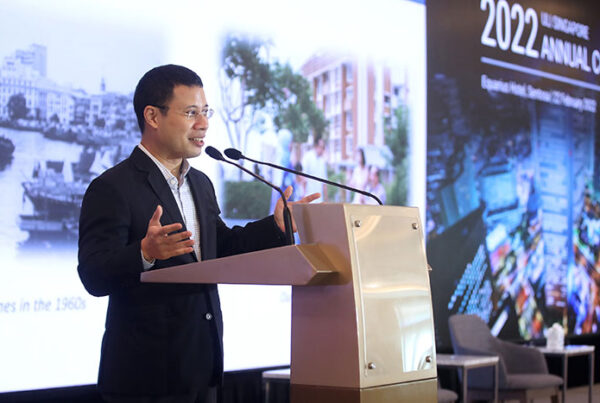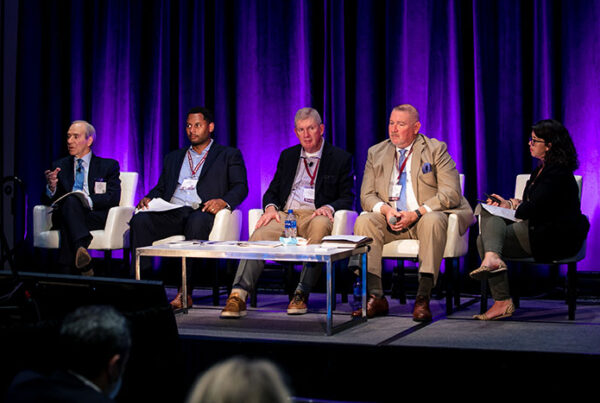NASA’s landing of the Perseverance rover on Mars in February and its deployment of a tiny robotic helicopter—both achieved in the midst of a pandemic—provide a lesson in how teamwork, flexibility, and creativity can overcome daunting challenges, the mission’s chief engineer told attendees participating in ULI’s Virtual Spring Meeting.
COVID-19 has shown that “we can adjust to tremendous disruptions in our expectations of tomorrow,” said Adam Steltzner, leader of a team that worked for nearly a decade to prepare for landing a $2.5 billion spacecraft on the surface of a world nearly 300 million miles (480 million km) away.
Steltzner, who also headed a team that accomplished the landing of the Curiosity Rover on Mars in 2012, said NASA staffers—accustomed to working together in large numbers during missions—had to reinvent their work style.
“Usually, it would be 50 of us in a room, shoulder to shoulder,” Steltzner said. Instead, team members worked remotely or gathered in groups of six, with masks and social distancing, as they grappled with the myriad details of getting the complex spacecraft to touch down safely instead of leaving “a smoking hole on the surface of Mars.”
“Meeting the moment in this disrupted and unknown future required ingenuity,” Steltzner said.
Even when there is not a pandemic, landing is a considerable challenge because only 40 percent of attempts to land spacecraft on Mars have succeeded, according to NASA’s website.
Perseverance’s descent to the Martian surface—the infamous “seven minutes of terror” for Mission Control—required it to quickly slow from 12,500 miles per hour (20,000 kph) to zero. After initially relying on a parachute and a heat shield, during the final portion of the descent the rover was dangled on cables beneath a jet pack, which lowered it to the surface and then detached.
That technique, originally developed for the 2012 Curiosity rover mission, enabled the rover to use its own wheels and suspension to touch down more safely on the rough Martian surface, as Steltzner detailed in his 2016 book The Right Kind of Crazy: A True Story of Teamwork, Leadership and High-Stakes Innovation.
For the latest mission, Steltzner’s team had to figure out how to attach the Ingenuity robotic helicopter to the Perseverance rover so it would make it to Mars in working condition. The original plan was to fit it on the side of the craft, which would have required getting the helicopter’s rotors to fold in half. It was not clear that detail could be worked out in time for the launch, and Ingenuity was in danger of not making it to Mars, Steltzner said.
To solve the problem, Steltzner and his staffers “called an audible,” as he put it, and attached the copter under the rover’s body, covering it with a pan to protect against the high-energy jet of dust that bounced against the spacecraft as it landed. The audible worked.
Steltzner cited that move as an example of the sort of flexibility and agility that can help teams in other endeavors get through a crisis, as well. Teams can overcome difficult situations by learning to appreciate members’ attributes rather than focusing on negatives, he said.
“In my business, a lot of people see the elephant from different perspectives,” Steltzner said. “They all have their own understanding of what is important.”
Leaders need to establish an “open culture” in which staffers can use their curiosity and imagination and get over their fear of coming up with a wrong answer, he said. Leaders have to model that approach themselves and be willing to criticize their own ideas.
The pandemic has provided “a teaching moment” by forcing leaders and organizations to streamline their work processes and eliminate nonessential activities, Steltzner said. The crisis has shown “how we’ve been able to do less—that it might be a more efficient and cost-effective way when we come out of this,” he said.
To maintain collaboration among team members, Steltzner had them hold unstructured meetups in which a pair of staffers would schedule a 15-minute video chat with no specific agenda in order to simulate the sort of casual interaction they normally would have in the hallway or elevator.
Steltzner also combined videoconferencing with old-school communications tools, he said, such as a whiteboard rather than their digital replacements. “I know how to design things on a whiteboard,” he explained.
When NASA originally announced in March 2020 that the rover would be named Perseverance, Steltzner said he initially was puzzled by the name. “I’m thinking Perseverance—that suggests that you’re struggling,” he recalled. “That seems weird, when we’re not struggling against anything.” Then, four days later, his lab was shut down by the pandemic.
In the end, the name turned out to be “perfect for the moment,” Steltzner said.



